Opinion & Analysis
The death of the 3-iron and what it means for your bag setup

The 3-iron is almost extinct. It sounds like an odd statement, but it’s very true. Don’t believe me? Go try and buy one in a set. They are not easily found.
As we evaluate this topic, I’ll refrain from specs from “players” clubs as these are not the irons normally purchased. Yeah, it might skew the data, but even the players capable of playing the long irons are opting out of the 3 iron. And let’s be honest, should any of us be playing a blade 3-iron?
Mizuno only offers 4-PW in the JPX line now. Titleist only offers a 3-iron in T100s, while the rest are void of 3-irons. TaylorMade provides 4-PW in the P790, P790Ti, and P770. Callaway has done the same, only offering a 3-iron in the “players line” of clubs, while the rest is again void of the-iron. Cobra golf has also followed suit.
So are 3-irons just too hard to hit? Is that why no one is buying them, thus causing the OEMs to stop making them? The only ones left to buy are the “players” 3 irons, and those aren’t even reasonable unless you’re a professional.
What if I told you we were being deceived? What if I told you the 3-iron is still very much alive in all the iron sets available but under the guise of a different number?
Let’s hop into the “wayback machine” and take a quick look at the history of iron lofts.
The year is 1970, and the vast majority of irons available are blades. You know, the razor-sharp leading edges that are ready to break your wrist with a deep divot.
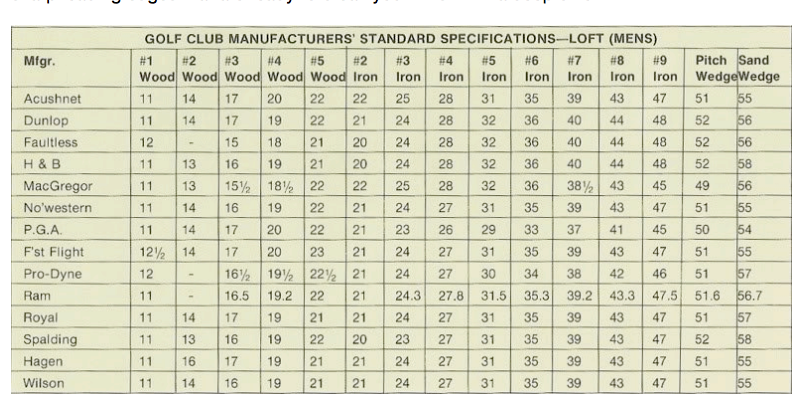
The image above is an actual snippet from a catalog from the ’70s. At this point, the 1-iron was virtually extinct, and in 1975, Lee Trevino was immortalized by his joke about how God couldn’t hit a 1-iron, which typically fell in the 18-degree range at the time. 2-irons were standard issue in the set, and the lowest loft you might find is 20 degrees.
Then the ’80s came, and things started to progress. As you might expect, lofts started to decrease. It wasn’t because of flight windows, or launch numbers, because they didn’t have that kind of technology readily available to measure those attributes. It was simply a quest for distance.
Then in the ’90s, you’d pretty much see all iron sets with 21-degree 3-irons, down to 48-degree PW’s, and 21 degrees being the norm for the lowest lofted 3-iron. 2-irons at this time were typically 18 degrees and available by request only.
Then came the 2000’s, an era we all should be familiar with. This is where things started to get interesting. Not only because lofts continued to be strengthened, but because the hybrid became a new option to replace the long irons. Adams Golf made a killing as it perfected this golf club, creating the Idea line that was in the bags of most of the senior tour players and many of the PGA Tour players. These were a fan favorite at retail too. The hybrid was an easy long iron to hit and quickly started to replace 3-irons in golf bags across the country and even on tour.
By this time the pitching wedge lofts started to get pushed to 46 degrees, which was a big jump, to be honest. In the 1970s, MacGregor was making pitching wedges with 49 degrees of loft. So, for the 90’s to be around 48 degrees, it wasn’t too much of a shock. But in the 2000s, we now saw PW’s drop to 46 degrees; a half club stronger. This is where the downfall began, in my opinion.
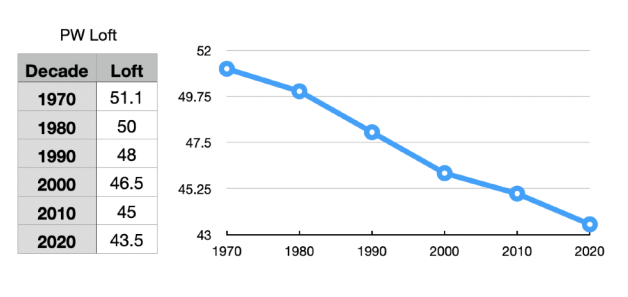
The first decade of the 21st century needed the gap wedge, also known as the approach wedge or utility wedge or just plain old “wedge.” Now, keep in mind, this club wasn’t anything new. The gap wedge existed ever since the beginning because at 50-52 degrees it was simply a pitching wedge from the ’70s. But it became a necessary element for the bag since the lofts of every iron were starting to move farther and farther away from the sand wedge.
Now in 2020, the average loft of the PW is 43.5 degrees, and the average 4-iron loft is 20.6 degrees. Turns out, the 4-iron from 2020 is .3 degrees stronger than the average 2-iron (20.9 degrees) from 1970. We have come full circle! Instead of maintaining those classic numbers, of 2, 3, 4, 5, 6, 7, 8, 9, PW, the new sets are labeled 4, 5, 6, 7, 8, 9, P, G.
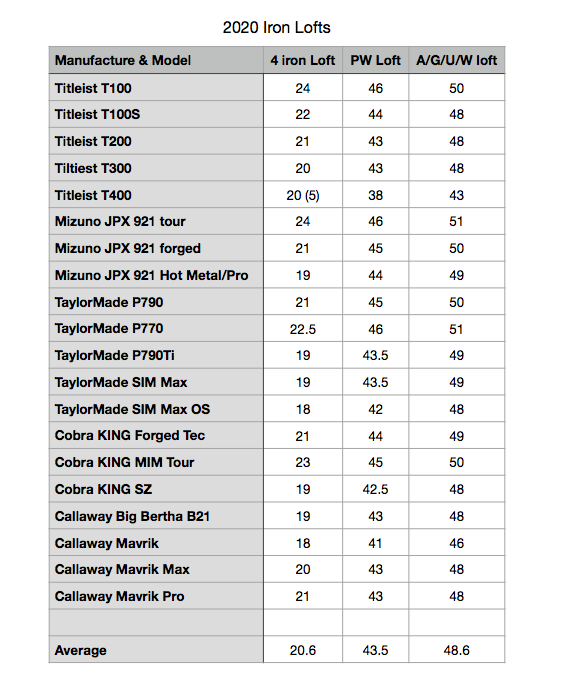
I wonder how many golfers out there carry a 4-iron thinking it’s a club they can hit? Probably too many! Obviously, the 3-iron is dead at this point, since it would actually carry the loft of the elusive 1-iron Trevino claimed was unhittable!
Now, it’s time to discuss how we got to this point. You’ll hear a lot of companies talk about “flight windows” or “launch angles” and how it was changed by engineering, lowering CG’s, and increasing speed through thin faces. Some will talk about how the ball has changed, and it just launches higher, and it requires the lofts to be strengthened, or it will just go too high!
I hate to be the bearer of bad news, but that is all a bunch of baloney, and here is why: They started making gap wedges as part of the set. If the launch was too high or the window was too different, why make a matching gap wedge with the same technology and have the loft of a pitching wedge from the 1990s? Wouldn’t that launch or window then be too high for that club too? And yet you still need to buy another gap wedge to fit the 52-degree range. If the average golfer bought a 2020 game improvement set today, they would find the set make up to be 5, 6, 7, 8, 9, PW (43.5 degrees), Gap #1 (48.6 degrees), Gap #2 (52 degrees). That means if you happen to carry a 56 and a 60 degree, you now have the same amount of label wedges (5) as you do irons (5)!
Five wedges in the bag! Does anyone think this is weird?
Furthermore, when was a higher launching iron shot a bad thing? Wouldn’t average golfers benefit from a steeper angle of descent so the golf ball stops quicker on the green?
I conducted a study where I tested a Titleist 716 MB 8-iron with 39 degrees of loft to a TaylorMade P790 9-iron with 40 degrees of loft. All the data was captured on the Foresight GC2 launch monitor. It wasn’t a perfect test since they didn’t have the same shaft or loft, but my findings were surprising none the less. They went the same distance, almost down to the decimal. The Titleist went 165.2 yards, and the TaylorMade went 165.1 yards. Launch was only .6 degrees different while peak height was less than four feet different. So, unless you are Tiger Woods, you are not noticing a difference out on the golf course.
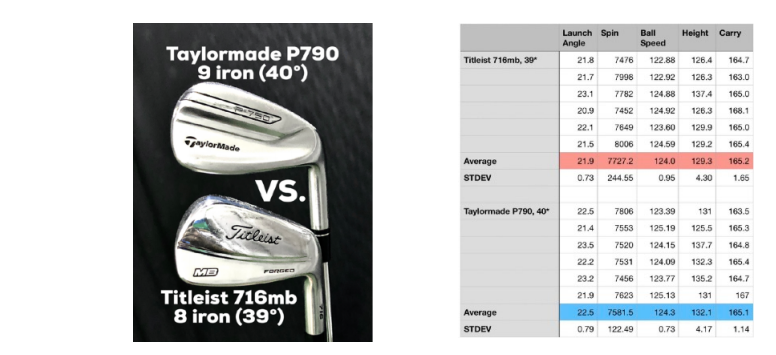
Some of you might think, “so, the label on the bottom of the club changed, it’s all going the same distance. So, what’s the big deal?” To me, it’s the confusion it creates more than anything. By decreasing the lofts, you’re just making the numbered iron go farther, and you are creating even bigger problems by having large gaps with the sand wedge when all amateurs need those clubs. It’s also putting clubs into the hands of golfers when they have no business hitting, like the 4-iron with 20 degrees of loft. Titleist has already made a T400 5-iron with 20 degrees of loft, and that’s just silly.
There also is the argument that golfers love distance, and when they start playing and can hit a 7-iron relatively far, it helps grow the game. Growing the game isn’t a bad thing, but if they are new to the game, they shouldn’t have any preconceived notions of how far to hit a 7-iron, and that means loft at that point becomes irrelevant.
I will not refute that a 40-degree lofted game improvement iron will be slightly longer than an identical lofted players club, but I think you’d be surprised to see the actual difference is a maximum of about three yards longer. The technology works, but by no means is it so substantial that we need to change the label on the bottom of the golf club.
The bottom line is that loft is king, regardless of the technology involved, and I have seen, but one equipment company make a change backwards! This is TaylorMade with their P770 irons. In comparison the P790, they increased the loft by one degree in the short irons and up to two degrees in the long irons, to add height and spin to the irons to improve performance. Imagine that, more spin and height are an advantage! And that was backed by their testing and their data.
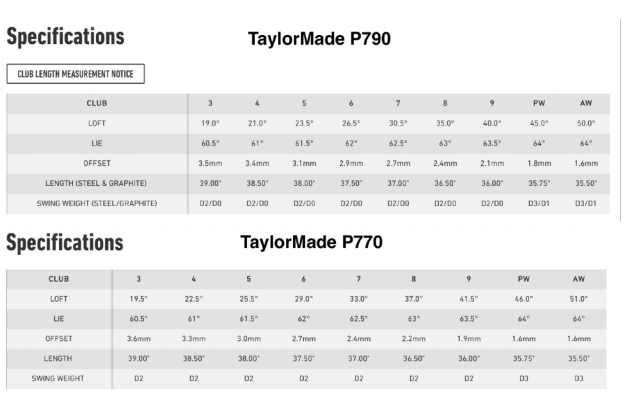
Now to even further nail down my point, it is worth noting that TaylorMade Golf offers the highest lofted Pitching Wedge in the industry at 49 degree, which are in the Tiger lofts of the P7TW irons. That same iron set has a 22.5-degree 3-iron. At 22.5 degrees, it is typically the lowest-lofted iron in the golf bag of the best iron player on the PGA Tour in 2019. Of course, he has the skill to play an iron with lower loft, but the point that history reveals to us is that the effective loft of playability for an iron is about 22 degrees and higher. Anything lower lofted than that is typically replaced with a hybrid. This is not just a trend for the amateur golfer either, and it is even happening on tour with the best players in the world.
We will probably never see the lofts rolled back, but the least we can do is update Lee Trevino’s quote, “if you ever find yourself in a thunderstorm, lift up your 4-iron, because not even God can hit a 4-iron.”
- LIKE985
- LEGIT115
- WOW66
- LOL30
- IDHT5
- FLOP7
- OB5
- SHANK32
19th Hole
Vincenzi’s 2024 Zurich Classic of New Orleans betting preview

The PGA TOUR heads to New Orleans to play the 2023 Zurich Classic of New Orleans. In a welcome change from the usual stroke play, the Zurich Classic is a team event. On Thursday and Saturday, the teams play best ball, and on Friday and Sunday the teams play alternate shot.
TPC Louisiana is a par 72 that measures 7,425 yards. The course features some short par 4s and plenty of water and bunkers, which makes for a lot of exciting risk/reward scenarios for competitors. Pete Dye designed the course in 2004 specifically for the Zurich Classic, although the event didn’t make its debut until 2007 because of Hurricane Katrina.
Coming off of the Masters and a signature event in consecutive weeks, the field this week is a step down, and understandably so. Many of the world’s top players will be using this time to rest after a busy stretch.
However, there are some interesting teams this season with some stars making surprise appearances in the team event. Some notable teams include Patrick Cantlay and Xander Schauffele, Rory McIlroy and Shane Lowry, Collin Morikawa and Kurt Kitayama, Will Zalatoris and Sahith Theegala as well as a few Canadian teams, Nick Taylor and Adam Hadwin and Taylor Pendrith and Corey Conners.
Past Winners at TPC Louisiana
- 2023: Riley/Hardy (-30)
- 2022: Cantlay/Schauffele (-29)
- 2021: Leishman/Smith (-20)
- 2019: Palmer/Rahm (-26)
- 2018: Horschel/Piercy (-22)
- 2017: Blixt/Smith (-27)
2024 Zurich Classic of New Orleans Picks
Tom Hoge/Maverick McNealy +2500 (DraftKings)
Tom Hoge is coming off of a solid T18 finish at the RBC Heritage and finished T13 at last year’s Zurich Classic alongside Harris English.
This season, Hoge is having one of his best years on Tour in terms of Strokes Gained: Approach. In his last 24 rounds, the only player to top him on the category is Scottie Scheffler. Hoge has been solid on Pete Dye designs, ranking 28th in the field over his past 36 rounds.
McNealy is also having a solid season. He’s finished T6 at the Waste Management Phoenix Open and T9 at the PLAYERS Championship. He recently started working with world renowned swing coach, Butch Harmon, and its seemingly paid dividends in 2024.
Keith Mitchell/Joel Dahmen +4000 (DraftKings)
Keith Mitchell is having a fantastic season, finishing in the top-20 of five of his past seven starts on Tour. Most recently, Mitchell finished T14 at the Valero Texas Open and gained a whopping 6.0 strokes off the tee. He finished 6th at last year’s Zurich Classic.
Joel Dahmen is having a resurgent year and has been dialed in with his irons. He also has a T11 finish at the PLAYERS Championship at TPC Sawgrass which is another Pete Dye track. With Mitchell’s length and Dahmen’s ability to put it close with his short irons, the Mitchell/Dahmen combination will be dangerous this week.
Taylor Moore/Matt NeSmith +6500 (DraftKings)
Taylor Moore has quickly developed into one of the more consistent players on Tour. He’s finished in the top-20 in three of his past four starts, including a very impressive showing at The Masters, finishing T20. He’s also finished T4 at this event in consecutive seasons alongside Matt NeSmith.
NeSmith isn’t having a great 2024, but has seemed to elevate his game in this format. He finished T26 at Pete Dye’s TPC Sawgrass, which gives the 30-year-old something to build off of. NeSmith is also a great putter on Bermudagrass, which could help elevate Moore’s ball striking prowess.
- LIKE6
- LEGIT1
- WOW1
- LOL0
- IDHT0
- FLOP2
- OB1
- SHANK1
19th Hole
Vincenzi’s 2024 LIV Adelaide betting preview: Cam Smith ready for big week down under

After having four of the top twelve players on the leaderboard at The Masters, LIV Golf is set for their fifth event of the season: LIV Adelaide.
For both LIV fans and golf fans in Australia, LIV Adelaide is one of the most anticipated events of the year. With 35,000 people expected to attend each day of the tournament, the Grange Golf Club will be crawling with fans who are passionate about the sport of golf. The 12th hole, better known as “the watering hole”, is sure to have the rowdiest of the fans cheering after a long day of drinking some Leishman Lager.
The Grange Golf Club is a par-72 that measures 6,946 yards. The course features minimal resistance, as golfers went extremely low last season. In 2023, Talor Gooch shot consecutive rounds of 62 on Thursday and Friday, giving himself a gigantic cushion heading into championship Sunday. Things got tight for a while, but in the end, the Oklahoma State product was able to hold off The Crushers’ Anirban Lahiri for a three-shot victory.
The Four Aces won the team competition with the Range Goats finishing second.
*All Images Courtesy of LIV Golf*
Past Winners at LIV Adelaide
- 2023: Talor Gooch (-19)
Stat Leaders Through LIV Miami
Green in Regulation
- Richard Bland
- Jon Rahm
- Paul Casey
Fairways Hit
- Abraham Ancer
- Graeme McDowell
- Henrik Stenson
Driving Distance
- Bryson DeChambeau
- Joaquin Niemann
- Dean Burmester
Putting
- Cameron Smith
- Louis Oosthuizen
- Matt Jones
2024 LIV Adelaide Picks
Cameron Smith +1400 (DraftKings)
When I pulled up the odds for LIV Adelaide, I was more than a little surprised to see multiple golfers listed ahead of Cameron Smith on the betting board. A few starts ago, Cam finished runner-up at LIV Hong Kong, which is a golf course that absolutely suits his eye. Augusta National in another course that Smith could roll out of bed and finish in the top-ten at, and he did so two weeks ago at The Masters, finishing T6.
At Augusta, he gained strokes on the field on approach, off the tee (slightly), and of course, around the green and putting. Smith able to get in the mix at a major championship despite coming into the week feeling under the weather tells me that his game is once again rounding into form.
The Grange Golf Club is another course that undoubtedly suits the Australian. Smith is obviously incredibly comfortable playing in front of the Aussie faithful and has won three Australian PGA Championship’s. The course is very short and will allow Smith to play conservative off the tee, mitigating his most glaring weakness. With birdies available all over the golf course, there’s a chance the event turns into a putting contest, and there’s no one on the planet I’d rather have in one of those than Cam Smith.

Louis Oosthuizen +2200 (DraftKings)
Louis Oosthuizen has simply been one of the best players on LIV in the 2024 seas0n. The South African has finished in the top-10 on the LIV leaderboard in three of his five starts, with his best coming in Jeddah, where he finished T2. Perhaps more impressively, Oosthuizen finished T7 at LIV Miami, which took place at Doral’s “Blue Monster”, an absolutely massive golf course. Given that Louis is on the shorter side in terms of distance off the tee, his ability to play well in Miami shows how dialed he is with the irons this season.
In addition to the LIV finishes, Oosthuizen won back-to-back starts on the DP World Tour in December at the Alfred Dunhill Championship and the Mauritus Open. He also finished runner-up at the end of February in the International Series Oman. The 41-year-old has been one of the most consistent performers of 2024, regardless of tour.
For the season, Louis ranks 4th on LIV in birdies made, T9 in fairways hit and first in putting. He ranks 32nd in driving distance, but that won’t be an issue at this short course. Last season, he finished T11 at the event, but was in decent position going into the final round but fell back after shooting 70 while the rest of the field went low. This season, Oosthuizen comes into the event in peak form, and the course should be a perfect fit for his smooth swing and hot putter this week.

- LIKE10
- LEGIT2
- WOW0
- LOL1
- IDHT0
- FLOP1
- OB1
- SHANK1
Opinion & Analysis
The Wedge Guy: What really makes a wedge work? Part 1

Of all the clubs in our bags, wedges are almost always the simplest in construction and, therefore, the easiest to analyze what might make one work differently from another if you know what to look for.
Wedges are a lot less mysterious than drivers, of course, as the major brands are working with a lot of “pixie dust” inside these modern marvels. That’s carrying over more to irons now, with so many new models featuring internal multi-material technologies, and almost all of them having a “badge” or insert in the back to allow more complex graphics while hiding the actual distribution of mass.
But when it comes to wedges, most on the market today are still single pieces of molded steel, either cast or forged into that shape. So, if you look closely at where the mass is distributed, it’s pretty clear how that wedge is going to perform.
To start, because of their wider soles, the majority of the mass of almost any wedge is along the bottom third of the clubhead. So, the best wedge shots are always those hit between the 2nd and 5th grooves so that more mass is directly behind that impact. Elite tour professionals practice incessantly to learn to do that consistently, wearing out a spot about the size of a penny right there. If impact moves higher than that, the face is dramatically thinner, so smash factor is compromised significantly, which reduces the overall distance the ball will fly.
Every one of us, tour players included, knows that maddening shot that we feel a bit high on the face and it doesn’t go anywhere, it’s not your fault.
If your wedges show a wear pattern the size of a silver dollar, and centered above the 3rd or 4th groove, you are not getting anywhere near the same performance from shot to shot. Robot testing proves impact even two to three grooves higher in the face can cause distance loss of up to 35 to 55 feet with modern ‘tour design’ wedges.
In addition, as impact moves above the center of mass, the golf club principle of gear effect causes the ball to fly higher with less spin. Think of modern drivers for a minute. The “holy grail” of driving is high launch and low spin, and the driver engineers are pulling out all stops to get the mass as low in the clubhead as possible to optimize this combination.
Where is all the mass in your wedges? Low. So, disregarding the higher lofts, wedges “want” to launch the ball high with low spin – exactly the opposite of what good wedge play requires penetrating ball flight with high spin.
While almost all major brand wedges have begun putting a tiny bit more thickness in the top portion of the clubhead, conventional and modern ‘tour design’ wedges perform pretty much like they always have. Elite players learn to hit those crisp, spinny penetrating wedge shots by spending lots of practice time learning to consistently make contact low in the face.
So, what about grooves and face texture?
Grooves on any club can only do so much, and no one has any material advantage here. The USGA tightly defines what we manufacturers can do with grooves and face texture, and modern manufacturing techniques allow all of us to push those limits ever closer. And we all do. End of story.
Then there’s the topic of bounce and grinds, the most complex and confusing part of the wedge formula. Many top brands offer a complex array of sole configurations, all of them admittedly specialized to a particular kind of lie or turf conditions, and/or a particular divot pattern.
But if you don’t play the same turf all the time, and make the same size divot on every swing, how would you ever figure this out?
The only way is to take any wedge you are considering and play it a few rounds, hitting all the shots you face and observing the results. There’s simply no other way.
So, hopefully this will inspire a lively conversation in our comments section, and I’ll chime in to answer any questions you might have.
And next week, I’ll dive into the rest of the wedge formula. Yes, shafts, grips and specifications are essential, too.
- LIKE31
- LEGIT7
- WOW1
- LOL1
- IDHT2
- FLOP3
- OB1
- SHANK3
-

 19th Hole2 weeks ago
19th Hole2 weeks agoDave Portnoy places monstrous outright bet for the 2024 Masters
-

 19th Hole2 weeks ago
19th Hole2 weeks agoTiger Woods arrives at 2024 Masters equipped with a putter that may surprise you
-

 19th Hole18 hours ago
19th Hole18 hours ago‘Absolutely crazy’ – Major champ lays into Patrick Cantlay over his decision on final hole of RBC Heritage
-

 19th Hole3 weeks ago
19th Hole3 weeks agoReport: Tiger Woods has ‘eliminated sex’ in preparation for the 2024 Masters
-

 19th Hole1 week ago
19th Hole1 week agoTwo star names reportedly blanked Jon Rahm all week at the Masters
-

 19th Hole7 days ago
19th Hole7 days agoReport: LIV Golf identifies latest star name they hope to sign to breakaway tour
-

 19th Hole1 week ago
19th Hole1 week agoNeal Shipley presser ends in awkward fashion after reporter claims Tiger handed him note on 8th fairway
-

 19th Hole6 days ago
19th Hole6 days agoBrandel Chamblee has ‘no doubt’ who started the McIlroy/LIV rumor and why







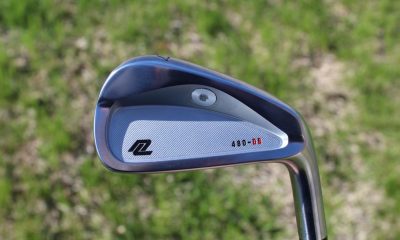













HfJeff
Feb 23, 2023 at 2:10 pm
I am a below average golfer and love the 3 iron. Not getting into the weeds of angles and loft and shifting weight, I hit it straighter and further than hybrids on the long fairway shots. I know it is a matter of practice makes perfect, but this old Dunlop 3 iron is coming along for the ride if I get a new set.
Kevin
Feb 9, 2022 at 1:01 am
What does it all matter.Just use the club that goes the required distance no matter what the number on the bottom of the club says.It seems that most club makers are selling to your ego .
Pingback: The 7 Best Golf Irons For High Handicappers In 2021 - DunedinGolf
Pingback: 2 Hybrid Vs 4 Wood – Which Club Is Better To Carry? - (MUST READ Before You Buy)
Todd
Apr 15, 2021 at 4:56 am
Best thing I’ve read in awhile. I’ve been trying to tell people this when we stand on a par 3 and I grab my Ping Eye 2 5-iron and they are pulling 7 and looking at me funny. People just don’t get it. This quest for “who can hit their irons the longest” is beyond silly. After driver (and arguably 3-wood, to reach long par 5’s in two), it’s distance CONTROL that is most important. If I need the ball to travel 165 yards to the pin, I don’t care if it says 6,7,8,9 or elephant on the bottom. It’s whatever implement gets the job done. If I knock my “6” iron stiff, and your “8” iron (which is the same club as my 6 with a different number stamped on the bottom), and you blow it over the green or sideways, what good did that do you?
TW
Mar 4, 2021 at 5:59 pm
I think they need to stop making sets in numbers. An ideal set for me would be driver, 3 wood at 14 degrees, 5 wood at 18 degrees. Then irons spaced out in 5 degree gaps, 20 25 30 35 40 45 50 55 60.. Putter to finish! I think that is 13 clubs but who cares, lighter for the caddy! It would remove ego as golfers would accept that some use the 40 degree iron to reach that 150 whereas some use the 35 or 30 iron! If golfers wanted to stop their set with the longest iron being 25 or 30 thats fine they can adopt a 25 degree fairway wood/hybrid! no marketing & no ego, simple really!
AMG PUMA
Feb 15, 2021 at 7:08 pm
A cavity back or whatever head shape golf club set with PW or GW stamped in the sole wont ever be a wedge. A wedge club has its own design.
HKO
Feb 13, 2021 at 1:44 am
almost the best article on WRX ’til the P770 part. why’d you ruin such good one with a silly shill at the end?
Mo
Feb 2, 2021 at 12:12 pm
@Taylormade for shame 42* pw? 18* 4i iron?
Utter joke
Rick
Feb 3, 2021 at 10:39 am
Sorry that club died 10 years ago
Tony Wright
Feb 1, 2021 at 7:40 am
Great article thanks!
Shallowface
Jan 31, 2021 at 2:15 pm
Perhaps it is time we did away with the terms woods, hybrids, and irons, and just referred to everything as a “club.” Driving club. 2 club, 13 degrees. 3 club 15 degrees. 4 club 18 degrees, whether wood, hybrid or iron. 5 club, 21 degrees, which is where some current 5 irons are starting to fall, and so on until you get to the wedges.
Benjamin Hendricks
Jan 31, 2021 at 9:04 am
I hit long irons well and have the speed to use them. My current 4 iron is 1* weak of standard at 23* and it goes as far as my 2 iron did in the 90’s. It at times is tough to stop on greens because the ball we play doesn’t spin as much on longer shots AND greens have gotten firmer and faster in the last 20 years. I used to hit 2 iron into greens and not worry about stopping the ball (balata days). Really the issue is #1 the ball doesn’t spin enough on long iron shots #2 greens are firmer and faster than ever and a WAY distant #3 is the clubs themselves. the reason good players are ditching long irons are #1 and #2, not the clubs themselves. irons are more accurate for high speed/high spin players usually, a hybrid or high lofted wood is only necessary because of the ball and conditions. We are being forced to stop the ball with height/angle of descent more and more every year.
Chris
Mar 12, 2021 at 5:05 pm
Your 4 iron is weak of standard. What standard is that? There your issue. There is NO standard in golf. It’s the worst used word ever.
iLovett
Jan 29, 2021 at 6:19 am
Also, that quote wasn’t about a 4 iron
iLovett
Jan 29, 2021 at 6:17 am
That’s weird, I have a new Taylormade P770 3 iron… it’s 19.5 degrees stock.
With the post-modern lofts it’s arguable that at 20-22 degree 4 irons are actually high launching 3 irons that stop. If you have speed and want some roll, you need a low spin 2 iron these days
James
Jan 26, 2021 at 6:04 pm
I absolutely love my Mavrik Pro 21 degree loft 4 Iron. Absolute go-to fairway finder. Way easier to hit and launch than older gear.
Bud
Jan 25, 2021 at 3:47 pm
Thank you for doing this article. I get tired of golf club sales people trying to compare my Ping eye2 + to there modern 7iron and telling me I hit theirs further.
Beeno
Jan 25, 2021 at 4:52 am
A few points as a counter argument:
1. You are still limited to 14 clubs in your bag and except for the driver and putter, the rest of the clubs need to travel an exact distance every time and all the time. The only thing the driver needs to do is travel as far as possible and land in a good spot for a second shot.
2. You mention most clubs sold in the 70’s were MB blades. The lofts on blades have not changed much even for today’s modern blades. These clubs are meant for good ball strikers and the reason elite golfers prefer to play them is distance and direction control. (There might be other reasons)
3. Your so called loft jacked clubs (GI and SGI) are meant for mid to high handicap players that need help with distance and elevation. If all these modern clubs with higher MOI and lower CG still had traditional lofts, the ball would go nowhere and too high for a slow swinging high handicap player and an elite player will struggle to get consistent yardages.
4. If you removed the numbers on all the irons and just added degrees of loft, your set make-up will still look the same as you are only allowed 14 clubs. Depending on your skill level, the type of club will obviously perform different for different types of players.
5. Because elite golfers are murdering golf courses, today’s courses are playing much longer for the average golfer. The modern golf ball can be blamed for this. The modern golf ball is designed for elite players with high swing speeds.
6. I’m sure if you have a bit of talent, put in the time to practice and hone your skills, get properly fit for your clubs and get lessons so someone can keep you in check, you will be able to hit any club produced (even a 1970’s 2-iron). Unfortunately we live in an era where we want things easily and we want it now and we don’t care about the cost to get it.
Shallowface
Jan 31, 2021 at 2:08 pm
The thing is, CGs are not lower today than they were several years ago. Check out the MPF measurements on The Golfworks website. Regardless of whether or not you agree with how they weigh the various factors to compe up with a points rating, the actual physical measurements of the clubheads DO NOT LIE.
Euan Hardman
Jan 22, 2021 at 11:20 am
Basically, what this excellent article is saying is that all the irons should have been re-stamped 2 numbers lower. The PW is actually an 8 iron and we have to buy a 48 AW (9 iron) and 52 GW (PW) to fill the gap.
Now I know why I have trouble with my 4 (2!) iron.
ChipNRun
Jan 18, 2021 at 7:30 pm
I carry a 22* CB Pro Tungsten set 4i (hollow head) refitted w/ a hybrid shaft. It’s a driving iron now, and gives a low fairly hot draw – one club that flies low when needed.
Kevin Ricciardelli
Jan 18, 2021 at 7:20 pm
The clubs could not be “jack-up” if the ball didn’t fly higher. Balata balls from the 70’s back, simply flew lower. Blade clubs flew lower due to higher COG. The lofts are stronger because they can still be playable. Look at the 3 iron lofts available from Ping. Standard, Power and Retro.
Karaten’s Ghost
Jan 18, 2021 at 4:17 pm
Everyone talks about loft-up like distances aren’t different.
Why does no one address that the ball goes further today all on its own? Test some of the jacked lofts with balata, and you may realise this isn’t just marketing.
Also, there’s more margin on a $300 hybrid than a $130 iron.
Cody Reeder
Jan 18, 2021 at 1:02 pm
Well written Weston,
Thanks!
Mark Paschal
Jan 18, 2021 at 7:00 am
This article ignores the other changes that go along with modern clubs that allow for higher launch angles and steeper descent angles. If you really just changed the numbers on 70’s clubs you would have much lower ball flight, less forgiveness, less solid contact due to the longer shafts. There is much more to an iron than loft, and comparing irons from different manufacturers with similar lofts doesn’t render the other variables moot. This was an enjoyable read but definitely from the “equipment hasn’t improved” camp.
Weston Maughan
Jan 19, 2021 at 11:33 am
I would probably need to write another 2 or 3 articles to cover all the aspects, but to say I’m from the camp that golf clubs haven’t improved is a stretch. It wasn’t an article discussing forgiveness of iron design, which we both know countless studies confirm low CG and perimeter weighting has become better each year.
Take into account all the other changes… golf ball, improvement of irons designs, low CG’s and shaft lengths increasing… regardless of all the factors you throw at it, every golf club since the inception of the game has had a loft between 8° and 62° and you can call them what ever you want, but you still need them in a consistent gapping.
Lastly, the rational of needing to preserve flights and trajectories appears to be a logical discussion. But how has this necessary change never touched the sand wedge. It’s some how avoided the changes all together and sits at 56°. If the preservation of flight due to ball changes and club design are true, we would need to have 50° sand wedges by now. Thoughts?
Ken
Jan 26, 2021 at 5:25 pm
Weston, you are spot on. I had two sets of irons, CDI 990 and JPZ-EZ identical lofts through the set just different numbers on the sole. I hit them the same distances even though one was an all steel players cavity and the other had plutonium embedded somewhere. Anyway truth be told the old clubs flew straighter because the lower MOI made them easier to square up at impact. Resistance to twisting at impact also means resistance to squaring up at impact. That’s why even pros don’t like to turn over their current drivers and use a 3 wood for that instead.
An additional issue with new clubs, an amateur does an online club fitting and they are asked how far they hit their 7 iron and they respond with the yardage their current 7-iron, which was a 5 iron at the time the fitting algorithm was created and they wind up with a shaft flex that is too stiff.
gregory aziz
Jan 17, 2021 at 9:04 pm
Well researched and enjoyable article but the author omitted the BEN HOGAN FORT WORTH 15 model,
which addressed this weighty subject of loft strengthening in 2015.
I am on my 2nd set and have not looked back.
Al Fiscus
Jan 25, 2021 at 9:42 am
Exactly- still on my first !! The undiscovered blessing of sets with 44 degree PW’s is that we GET TO fill in the 48 & 52, hopefully matching our 56 & 60.. Blades are far superior in ALL 4 of the upper lofts.. SCOR proved that, & they’re still in my bag..
Roy
Jan 17, 2021 at 9:00 pm
Best article on WRX in a long time – thanks!
Jake DeJong
Jan 18, 2021 at 10:07 am
Agreed. Thoroughly researched and well written.
Anyone in disagreement is just an ostrich.
Milo
Jan 17, 2021 at 8:28 pm
I’m gonna buy a 12.5° Lynx Prowler driving iron. Thoughts?
Micheal
Jan 17, 2021 at 2:43 pm
Your information is incorrect, I just bought a set of Taylormade P790’s 3 iron though pitching wedge.
Bob
Jan 17, 2021 at 1:15 pm
The 3-iron didn’t die. It was just given a different number. Please stop with the drama.
Dwight L. Cramer
Jan 17, 2021 at 11:08 am
The same thing has happened with fly fishing line weights. If you fly fish, you know that the line and the rod must match up (i.e., a 4 wt. line for a 4 wt. rod, a 6 wt. line for a 6 wt. rod). But, in the universal quest for distance (not just golfers have that obsession), the line manufacturers have embraced ‘technology’ to create a marketing advantage, and it’s taken them in one direction, while the rod manufacturers have done the same, and headed off elsewhere. In other words a brand xx line rated as 4 wt. and a brand yy rod rated at 4 wt. may not be compatible. This creates real confusion for the fisherman, especially the newbie, or the guy who’s more into fishing that gear. (Free hint for newbies to fly fishing–buy the Orvis entry level set up and be done with it.)
A golfer
Jan 17, 2021 at 10:54 am
This is a great article and I really appreciate the historical data provided. The one counter argument I would make is that the “long irons” in many of these sets look and behave very similarly to hybrids. I would bet that a 20* Hot Metal or Mavrik, for example, would launch materially higher than a 20* blade, unlike the 39-40* example provided.
A golfer
Jan 17, 2021 at 11:12 am
The other important counterpoint is that jacked lofts in game improvement sets are a way of helping offset the early extension and flip that poor players almost universally exhibit. These players present way too much loft at impact, so they may actually have less of an issue launching the ball up at any given loft and swing speed level.
Paolo
Jan 25, 2021 at 1:48 pm
This is the only advantage . To strengthening lofts .
Forget numbering irons just put the lofts on them .
A Golfer
Jan 17, 2021 at 10:49 am
This is a great article and I really appreciate the historical documents pulled out. The one counterpoint I would make on the long end, is that many of these sets have “long irons” that look and behave very much like hybrids. I think if you took a 20* Hot Metal or Mavrik and put it against a 20* blade you would see a material difference in launch angle, unlike with the 39-40* example you provided.
Webster
Jan 17, 2021 at 9:07 am
It’s all about the loft/length relationship to me. My 150 yd club has pretty much always had 40* loft and 36″ length. Started playing seriously in the mid-90’s and that was pretty much the std for an 8 iron. Today I’m playing X-hot Pros that have a 40*, 36″ club…it just happens to have a 9 stamped on it; still goes 150yds.
John Little
Jan 17, 2021 at 6:52 am
Instead of iron numbers why not just stamp loft numbers. 4 degrees apart. A typical conversation might be.I made the par 3 7th with my 38 degree. Oh really! I did it with my 42.
Munter
Jan 17, 2021 at 4:16 am
Not sure about all this “loft jacking” ballyhoo.
I replaced half my AP2s with Mizuno JPX Hot Metal Pros a few months ago – 4i to 7i. Best upgrade I’ve ever made. Literally. Period.
OK, so actually now I have two 7 irons. The AP2 is still used a lot, it goes about 145m. Pretty standard for a 14 handicap, right?
The amazing thing is this: the JPXs go loooong. I now pull out 4i on any hole where I need to go 180-190m. Sometimes it rolls out past 200m. Where I would have sprayed my 3-hybrid, now I pull out my 5i, with a LOT more confidence it will go straight and looong.
So, with all respect, i now play much better golf, not because my lofts are jacked, but because the “hot” technology actually works. Forgiveness + cranking distance when you middle it. This *cannot* simply be about lofts, otherwise I would have been getting the same results with my AP2s, just one club less.
Jake DeJong
Jan 18, 2021 at 10:09 am
Anecdotal. No facts. Come back with launch monitor results?
Nate
Jan 17, 2021 at 1:21 am
I read a lot of these articles from Golfwrx. This is a stand out. Nice work.
Reece
Jan 16, 2021 at 11:40 pm
I bought a brand new set p790’s this last week and it came with a 3 iron. In left hand no less.
Lefthack
Jan 16, 2021 at 9:21 pm
Great article. My newish irons were a 5-PW set of Nike Vapor Pro Combos and I’ve been on the search for the 3 and 4 (the 2 is only available in right hand). I scored a 3 off the classified that is 20 degrees and can’t wait to hit it. I have no issues hitting my 3h and 4h but they take up more room in the bag than irons would.
Rich Douglas
Jan 16, 2021 at 7:02 pm
I’ve always maintained the theory of “loft deflation,” even when countered with the launch angle issue.
But if you keep your head about you, it really doesn’t matter. The numbers on the clubs have shifted, but it’s still the same 14 clubs, more or less. So I don’t have a 3-iron, but everything is shift down and I fill the gap between the PW and the SW with a wedge. It’s still the same number of clubs doing the exact same things.
Two advantages here: First, it’s not just lower lofts. A 4-iron with a 3-iron’s loft is still a 4-iron in length. It’s 1/2-inch shorter and, thus, easier to hit on center. That makes the entire set easier to hit than before.
Second, low-lofted irons are being replaced with hybrids, which have better perimeter weighting, lower CGs, and are easier to hit and to loft.
But if everything shifts down, doesn’t that create a gap between the 3-wood and the rest of the set? Yes, but who cares? Most players cover it with a hybrid, better to hit than a true 3-iron. Besides, most players can’t hit the ball well enough for that gap to matter anyway.
I haven’t carried a 3-iron in nearly two decades, and I dumped my 4-iron recently. That’s because I went to single-length irons built at 36.5″ (8-iron length). You just can’t generate enough clubhead speed to get a 4-iron to gap properly anyway. But the advantages of single-length irons–so much more consistent–outweigh having to swap the 4-iron for the hybrid.
Frank
Jan 16, 2021 at 7:07 pm
I beg to differ on the 4-iron length with 3-iron loft, I have a set of Hogan blades from the 60s and the 2-iron is 38.75″ which is in between today’s 3-iron and 4-iron “standard” length. They’re not just decreasing the loft, they’re increasing the length, too.
Rich Douglas
Jan 16, 2021 at 7:08 pm
Not if you’re paying attention. And it certainly isn’t an industry trend.
KP
Jan 16, 2021 at 5:00 pm
Great article. I always feel like manufacturers use their marketing to trick people into thinking that they’ve engineered something special that gives players more distance and forgiveness. Fact is they’re bs’ing us into buying new equipment every year. Crossfield and Shiels have done many videos that demonstrate how little difference there is in golf equipment year to year.
Rich Douglas
Jan 16, 2021 at 7:07 pm
Especially in irons. There have been only a handful of useful developments since the days of forged blades and nothing else:
— Perimeter-weighted cast irons (starting with Ping)
— Perimeter-weighted forged irons (starting with Hogan Edge)
— Multi-metal designs (allowing for higher COR on faces, more extreme perimeter weighting, and altered CGs)
— Graphite shafts good enough for irons
That’s about it. That Nike sling thingy, the twice-a-year TM bouncy clubs, or anything else are just derivatives from the above.
Jon Barton
Jan 16, 2021 at 7:20 pm
The manufacturers have been very clever. They have slowly turned a set of 3iron to SW (9clubs) into a set of 5,6,7,8,9.W. (6 clubs) with an option to add a 4i and in some cases a 3i. Great deal for them 6clubs for the price of 9.
The SW is usually not included in a modern set.
So we golfers also get to choose an extra 3 wedges, lucky us. But just a minute, that means we now buy an extra 3.
So the original 9 shrinks to 6. With an option of buying an extra 5.
So we now buy 11 for the price 14!
Oh, and maybe a utility or two as well. ?
Michael R Geiger
Feb 14, 2021 at 7:22 am
100% spot on!
Brandon
Jan 16, 2021 at 4:43 pm
In my opinion, a set that starts with a 22* 4 iron and stops at a 46* pw is perfect. 4 degree gaps between each club. Carry a 18 or 19* 5w,hybrid, or utility iron. Whatever 3 wedges you want above your pw. If I played a set with a 43* pw I’d need 2 gap wedges, which is just ridiculous. I think loft jacking is just to pad the ego of the short hitter who thinks he is hitting his pw as far as a player hits their 8 or 9 iron.
Ben Wallace
Jan 16, 2021 at 4:37 pm
True. However, it doesn’t matter what the club is designated so long as the player can hit the club and knows the carry numbers for the club. I don’t care if the clubs have a number, symbol, degree listing, letters of the alphabet, or names of rock and roll bands as the club’s designation so long as I know which club I am pulling out the bag. I won’t be reaching for a long iron anyway. I play driver, 3w, 5w, 7w, 4h, 5i-PW, 54, 60, and putter.
Bas
Jan 19, 2021 at 5:17 am
Same, but I play 4w, 7w. And my irons are GI, so the lofts are probably a bit stronger, so they are 6i-AW (26-49 degrees).
I can’t hit an iron with a loft below 26 degrees.